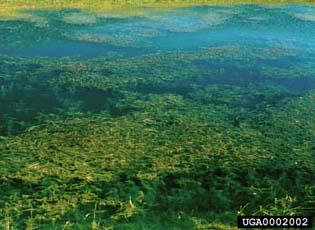Myriophyllum spicatum L. (ITIS)
Eurasian watermilfoil, spiked watermilfoil
Europe, Asia, and North Africa (Eiswerth et al. 2000)
Exact date unknown; between the 1880s and the 1940s (Eiswerth et al. 2000)
Unknown, possibly through the aquarium trade or transport of watercraft (Nichols and Shaw 1986)
Crowds out native species (Smith and Barko 1990)

Eurasian watermilfoil, infestation; dense canopy on surface at Cayuga Lake (New York)
Photo by Robert L. Johnson; Cornell University
Spotlights
Distribution / Maps / Survey Status
All Resources
Selected Resources
The section below contains highly relevant resources for this species, organized by source.
Council or Task Force
Partnership
Federal Government
International Government
State and Local Government
Academic
Eiswerth, M.E., S.G. Donaldson, and W.S. Johnson. 2000. Potential environmental impacts and economic damages of Eurasian watermilfoil (Myriophyllum spicatum) in western Nevada and northeastern California. Weed Technology 14(3):511-518.
Integrated Taxonomic Information System. Myriophyllum spicatum. [Accessed Aug 31, 2023].
Nichols, S.A., and B.H. Shaw. 1986. Ecological life histories of the three aquatic nuisance plants, Myriophyllum spicatum, Potamogeton crispus and Elodea canadensis. Hydrobiologia 131(1):3-21.
Smith C.G., and J.W. Barko. 1990. Ecology of Eurasian watermilfoil [PDF, 1.1 MB]. Journal of Aquatic Plant Management 28:55-64.
